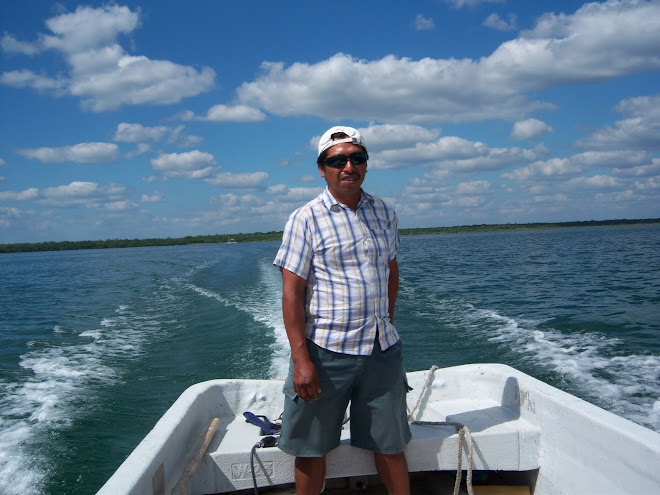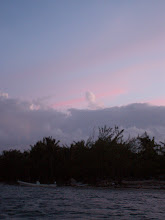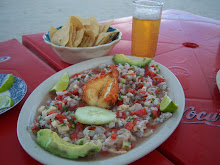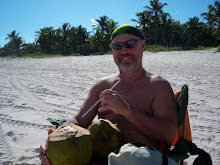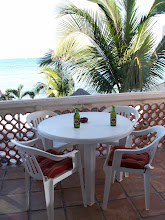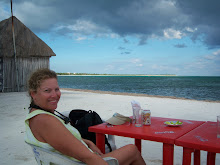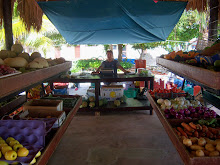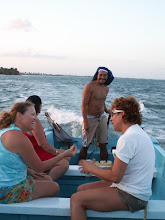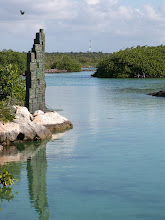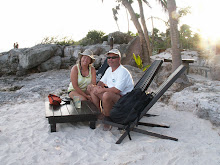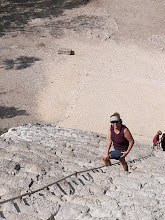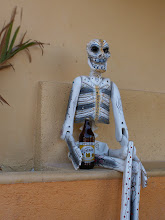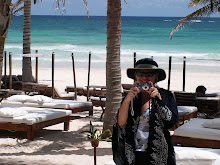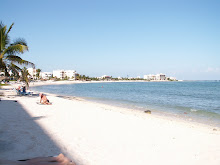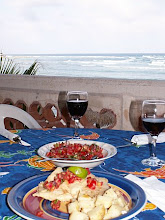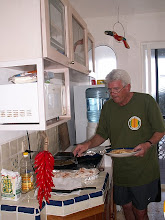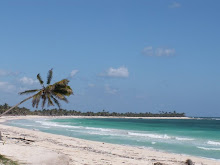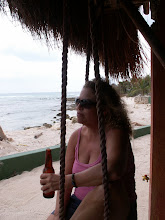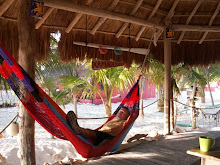One of the most spectacular sights in the Yucatan area are the Mayan ruins that
populate this region. From small ruins on the side of the road or glimpsed through the jungle, to palatial structures that dominated ancient cities, there is much to see.
A basic guide book for the area, such as a Fodor’s or Frommer’s will give you a lot of information to digest and is a good start. Read these or something similar before you
go for a quick orientation. The best way to really enjoy the ruins, however, is to hire a guide near the admissions gate. These are educated and authorized people who speak
the language you require and are worth every penny of their charge. (Approx $40 for
a tour of a large ruin site such as Chichen Itza.)
When you hire a guide, you are able to follow along and really enjoy the sights. They
can bring history alive and conjure visions of mighty empires stretching for a thousand miles through the jungles, royal hierarchies battling for supremacy, and common people
laboring for the beauty still standing before you.
There are many Mayan ruins all reachable in a day trip from the Yucatan coast, the largest and most impressive being Chichen Itza. The last time we visited, about five years ago, you were still permitted to climb the great Castillo or pyramid, and also to
climb the inner staircase to the beautiful Jaguar altar. Alas, these are now closed to the
public, but there is still much to marvel over in this gorgeous city of stone.
Many Mayan ruins are lesser known and still under excavation. The ruins of Coba, just west of Tulum is one of these, and features another great pyramid that is still able to be climbed. This is a great site to explore, as it retains much of it’s jungle setting which creates a cooler (temperature-wise) and more atmospheric environment.
There are dozens of ruins scattered throughout the area, check your guide book and go explore these mystic marvels!
Some hints for seeing the ruins:
-Go early! Tour buses often arrive about 10am. Get there when the site opens, often 8am and you will have the place to yourself for awhile.
-Bring water and a hat. The sun is fierce inland and you will need hydration.
-Wear sturdy shoes. The ruins often cover vast areas, and good shoes will allow you to
explore and climb at will, if permitted.
-Which brings me to the last point: PLEASE obey posted signs regarding climbing or touching the ruins! You are a guest at a heritage site and manners are required!
Friday, August 28, 2009
Wednesday, August 19, 2009
Fishing Adventures
One of the best fishing trips I have ever taken was in a little panga leaving a small bay with a captain and mate, my husband and I. I had never looked at the shoreline
from the sea, so consequently I was fascinated trying to pick out landmarks and get
different views of some of the villas and condo buildings that line the shore.
As we motored north, there were many areas still undeveloped; small lagoon inlets and sandy beaches, thick jungle.
On to the fishing! We trolled with four rods in the water, moving north along the shoreline. The water was sapphire blue. No bites. We turn south and move farther offshore and see bigger boats from the large marinas in Puerto Adventuras. We wave from our tiny panga, clutching our little bench seats. Suddenly a pole jerks and the mate is handing it to me and shouting in Spanish. I get the idea and start reeling the line and then my husband gets a bite. I reel in my fish, an eight pound Spanish Mackeral and my husband lands a similar sized barracuda. The only difference being, my fish had the tail end of it chomped off (probably by a shark, they sense helplessness) while I reeled it in.
It lay thrashing and bleeding in the bottom of the boat, as I looked on and moved as far away from it as possible!
A successful fishing trip! And a lovely bonus is that the local restaurant will prepare a multitude of dishes with your fish for your pleasure that evening, or you can take it home and prepare it yourself. We usually also give the captain and mate some of the fish, as well as the customary cash tip.
There are many other types of fishing to be found in the area, from freshwater lagoons or lake fishing to salt flat bone fishing or larger game fishing like marlin or sailfish. The choices in outfitters or guides are plentiful, so get out there and go catch dinner!
from the sea, so consequently I was fascinated trying to pick out landmarks and get
different views of some of the villas and condo buildings that line the shore.
As we motored north, there were many areas still undeveloped; small lagoon inlets and sandy beaches, thick jungle.
On to the fishing! We trolled with four rods in the water, moving north along the shoreline. The water was sapphire blue. No bites. We turn south and move farther offshore and see bigger boats from the large marinas in Puerto Adventuras. We wave from our tiny panga, clutching our little bench seats. Suddenly a pole jerks and the mate is handing it to me and shouting in Spanish. I get the idea and start reeling the line and then my husband gets a bite. I reel in my fish, an eight pound Spanish Mackeral and my husband lands a similar sized barracuda. The only difference being, my fish had the tail end of it chomped off (probably by a shark, they sense helplessness) while I reeled it in.
It lay thrashing and bleeding in the bottom of the boat, as I looked on and moved as far away from it as possible!
A successful fishing trip! And a lovely bonus is that the local restaurant will prepare a multitude of dishes with your fish for your pleasure that evening, or you can take it home and prepare it yourself. We usually also give the captain and mate some of the fish, as well as the customary cash tip.
There are many other types of fishing to be found in the area, from freshwater lagoons or lake fishing to salt flat bone fishing or larger game fishing like marlin or sailfish. The choices in outfitters or guides are plentiful, so get out there and go catch dinner!
Sunday, August 16, 2009
The Weather
Whatever you do, do not look at the weather reports for the Yucatan before you go!
The weather is so changeable, that to try to predict the weather is a fool’s errand.
You can be sure it will be sunny and warm for the majority of your trip no matter
what time of year you go. The warm trade winds buffet the coast all year long, so
even the summer is nice. Here are the seasons:
Winter: Sunny and warm, with less humidity, the occasional cool evening. Water temps in the 70’s, daytime highs in the 80’s. Great season for inland exploring ruins or colonial cities like Merida.
Spring: Sunny and warm, days are lengthening, so lots of time for the beach and excursions. Breezy with daytime highs in the high 80’s.
Summer: Sunny and warm, with an occasional passing thunderstorm, daytime high’s in the 90 degree range. This is a great time to be in Mexico, it stays light longer and you can
linger on the beach til late. Water temps fabulous, in the 80’s, you will never want to get
out of the sea! Hot inland at ruins or jungle settings.
Fall: Sunny and warm, cooler nights begin to creep in. Quiet beaches in the low season
and the water stays nice and warm.
As you can see, you can expect sunny, warm days whenever you visit the Yucatan.
Try every season, you will find something to like about each one!
The weather is so changeable, that to try to predict the weather is a fool’s errand.
You can be sure it will be sunny and warm for the majority of your trip no matter
what time of year you go. The warm trade winds buffet the coast all year long, so
even the summer is nice. Here are the seasons:
Winter: Sunny and warm, with less humidity, the occasional cool evening. Water temps in the 70’s, daytime highs in the 80’s. Great season for inland exploring ruins or colonial cities like Merida.
Spring: Sunny and warm, days are lengthening, so lots of time for the beach and excursions. Breezy with daytime highs in the high 80’s.
Summer: Sunny and warm, with an occasional passing thunderstorm, daytime high’s in the 90 degree range. This is a great time to be in Mexico, it stays light longer and you can
linger on the beach til late. Water temps fabulous, in the 80’s, you will never want to get
out of the sea! Hot inland at ruins or jungle settings.
Fall: Sunny and warm, cooler nights begin to creep in. Quiet beaches in the low season
and the water stays nice and warm.
As you can see, you can expect sunny, warm days whenever you visit the Yucatan.
Try every season, you will find something to like about each one!
Wednesday, August 12, 2009
You're going to love the food!
When you travel in the Yucatan, you will experience wonderful, inexpensive meals if you follow the locals! Be adventurous and you will be rewarded with flavorful food from the land and the sea. Be on the look out for small carts on the side of the road, where workers mill about and line up for tacos and tortas (sandwiches), hot foods and cold drinks. Seek out restaurants on side streets of popular towns like Playa del Carmen
or Tulum and look for places filled with brown faces and satisfied smiles. These places will not be fancy, but feature real homecooked food, often made with different cuts of meats or types of cheeses you have never eaten such as beef tonque or asadero cheese.
Do visit a market or produce store and wonder at five kinds of mangoes, a multitude of peppers and chiles, both dried and fresh, and many items you may not recognize such as: yucca, jicama, cactus leaves, and squashes of every description. If you are lucky enough to have rented a condo or villa and have a kitchen, pick up some homemade tortillas at the tortilleria. Sauté some vegetables, fold in some cheese and your quesadilla is ready to wrap and take to the beach!
or Tulum and look for places filled with brown faces and satisfied smiles. These places will not be fancy, but feature real homecooked food, often made with different cuts of meats or types of cheeses you have never eaten such as beef tonque or asadero cheese.
Do visit a market or produce store and wonder at five kinds of mangoes, a multitude of peppers and chiles, both dried and fresh, and many items you may not recognize such as: yucca, jicama, cactus leaves, and squashes of every description. If you are lucky enough to have rented a condo or villa and have a kitchen, pick up some homemade tortillas at the tortilleria. Sauté some vegetables, fold in some cheese and your quesadilla is ready to wrap and take to the beach!
Tuesday, August 11, 2009
Get in the car and drive!
Driving in any foreign country is an adventure and there are certainly some places where it is advised not to drive, but the Riviera Maya is a fairly easy place to rent a car and get around. There are certain caveats (see sidebar) but as a general rule driving can be quite economical and a great way to really see the authentic parts of the area. When you have a car, you can visit small town taco stands, thrilling cenotes and caves, and almost deserted beaches, usually all within a few miles of where you are. The most important thing to remember about driving is that you are a tourist, therefore you should be driving generally slower than everyone else. This implies a certain courtesy, so move out of the way when cars behind you want to pass! The roadways frequently have pedestrians waiting nearby, sometimes in large gatherings for transportation, and care should be given anywhere you see pedestrian overpasses or intersections. The rewards of pulling into a thatched roof cement pad restaurant on the side of the road with plastic chairs full of local people with lots of food on their tables makes the sometimes minor hassles of renting a car all worthwhile.
Sidebar:
Rent from a reputable car rental agency, either at the airport or off the airport (they will come pick you up when you arrive) in advance over the internet. Remember that the car size categories are much smaller than the US standard, so choose appropriately. Most importantly, get full insurance coverage and check the car carefully. Pay with a credit card so you have all that protection that yours may offer.
Be aware of the gas station scam! When you pull up to the gas station (Pemex) have your pesos ready to show the attendant how much gas you want. Be sure the pump is zeroed out before he pumps. One person should keep their eyes on the pump numbers at all times. Do not be distracted by the attendant trying to point out something on the tire, etc. Show the pesos (i.e. 200) say “200 pesos, and do not take your eyes off the transaction. Sometimes they will try to switch bills to make you think you did not give them enough pesos.
Be aware of the speed bumps (called topes). They are often unmarked and can damage your car or health! If you see a walk-over the highway, there will be topes!
Be aware of the speed limit even though everyone will be breaking it! If the police pull you over for any reason, they will tell you that you need to follow them to the police station to get your license back. Tell them you would like to pay the fine right here and offer $20. Do not show any other cash, and do not tell them if you are on your way to the airport (they may try to hold you even longer to make you desperate to hand over even more cash)
You will probably more than likely not experience these driving hazards, except the topes, but it is good to be aware, and the gas station scam is very common.
Sidebar:
Rent from a reputable car rental agency, either at the airport or off the airport (they will come pick you up when you arrive) in advance over the internet. Remember that the car size categories are much smaller than the US standard, so choose appropriately. Most importantly, get full insurance coverage and check the car carefully. Pay with a credit card so you have all that protection that yours may offer.
Be aware of the gas station scam! When you pull up to the gas station (Pemex) have your pesos ready to show the attendant how much gas you want. Be sure the pump is zeroed out before he pumps. One person should keep their eyes on the pump numbers at all times. Do not be distracted by the attendant trying to point out something on the tire, etc. Show the pesos (i.e. 200) say “200 pesos, and do not take your eyes off the transaction. Sometimes they will try to switch bills to make you think you did not give them enough pesos.
Be aware of the speed bumps (called topes). They are often unmarked and can damage your car or health! If you see a walk-over the highway, there will be topes!
Be aware of the speed limit even though everyone will be breaking it! If the police pull you over for any reason, they will tell you that you need to follow them to the police station to get your license back. Tell them you would like to pay the fine right here and offer $20. Do not show any other cash, and do not tell them if you are on your way to the airport (they may try to hold you even longer to make you desperate to hand over even more cash)
You will probably more than likely not experience these driving hazards, except the topes, but it is good to be aware, and the gas station scam is very common.
Monday, August 10, 2009
Beaches!
Turn off the highway towards the east onto any dirt road that may have a sign that says “playa” and one of the many pearls that string the shore line in the Riviera Maya will be revealed where the road meets the sea. Up and down the coast, beautiful half moon shaped bays both large and small offer an authentic experience. Be careful, the road may be rutted and rough, and at the end there may be a man who asks for pesos and points to parking, or maybe a small beach club where you buy some cold beers for the privilege of sitting on the powder white sand where there is no one else. Unless it’s Sunday, a lovely day to watch all the hard working local people enjoy their beautiful land. The sea may be sandy or rocky, rough or practically flat, but it will always be ten shades of blue. Blue that cools the eyes and calms the mind.
Cenotes!
Just take a turn anywhere you see a sign that says “cenote” and you will be blessed with cool, fresh water to rinse the salt from your body and refresh your sunbaked head. Pay a small fee to the gate person, who is probably the owner of the private property you are visiting. Wear sturdy shoes; sometimes you may have to walk a bit, and the limestone rock that makes up the bulk of the topography in this area is impossible to negotiate barefoot. You may need your shoes to climb out of the cenote, so water shoes are best.
Search for cenotes with cliffs for jumping from and be daring. The water is so clear, it’s impossible to tell how deep it is until you get in and look beneath the surface. Frequently it will be 30 to 50 feet deep, so jump away! Feel the exhilaration of flying through the air and splashing down in the mineral rich water. Sometimes there will be a rope or old wooden ladder to haul yourself out and do it again, many times you will crawl across slippery rocks and make your way back up the hill to the cliff or platform. Bring your snorkel mask and look around, you will not see many fish, but beautiful cave formations
and stalagtites. Better yet is a scuba tour of these fine cave systems if you are certified.
Then you will be treated to an underwater visual feast as you shine your light upon colorful natural creations hundreds of thousands of years old. Cenotes have been fresh water sources for this region since the times of the indigenous peoples, so treat the cenote with the respect and reverence they practiced. These are a phenomenon unique to this region of the country of Mexico and the Caribbean so don’t miss it.
Search for cenotes with cliffs for jumping from and be daring. The water is so clear, it’s impossible to tell how deep it is until you get in and look beneath the surface. Frequently it will be 30 to 50 feet deep, so jump away! Feel the exhilaration of flying through the air and splashing down in the mineral rich water. Sometimes there will be a rope or old wooden ladder to haul yourself out and do it again, many times you will crawl across slippery rocks and make your way back up the hill to the cliff or platform. Bring your snorkel mask and look around, you will not see many fish, but beautiful cave formations
and stalagtites. Better yet is a scuba tour of these fine cave systems if you are certified.
Then you will be treated to an underwater visual feast as you shine your light upon colorful natural creations hundreds of thousands of years old. Cenotes have been fresh water sources for this region since the times of the indigenous peoples, so treat the cenote with the respect and reverence they practiced. These are a phenomenon unique to this region of the country of Mexico and the Caribbean so don’t miss it.
Subscribe to:
Posts (Atom)


